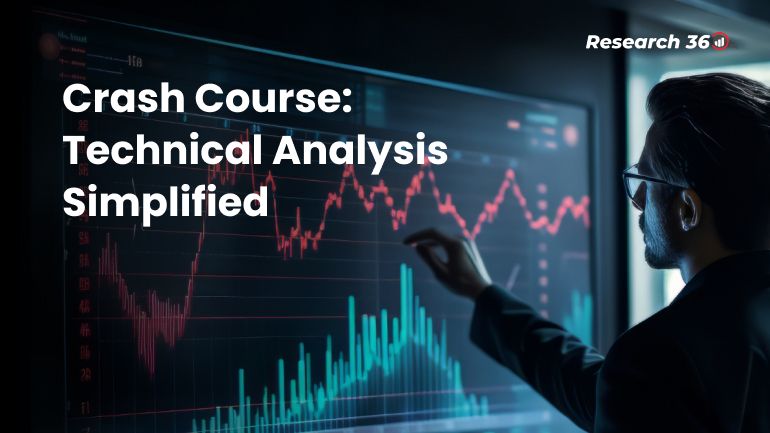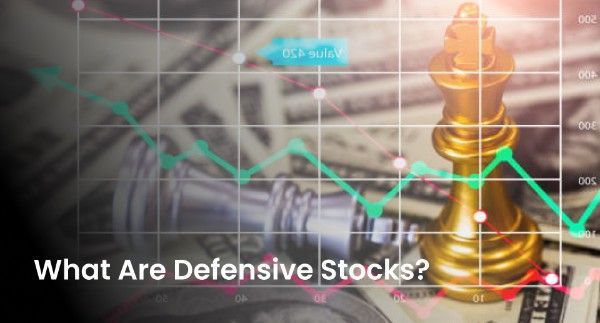Technical Analysis: ROC, RSI, SMA, EMA, MACD and DEMA

Technical analysis involves evaluating various technical indicators like ROC, RSI, MACD, SMA EMA and more. Find out what they are and how to calculate or interpret them.
Trading in the markets is all about identifying potentially strong price movements (or a lack thereof) and using strategies to leverage the kind of price changes you expect. However, predicting and analysing price trends is a complex task. It is not possible to simply look at the price of a stock today and predict how it may move tomorrow.
To better understand what historical price movements mean and what they may tell you about how a stock is expected to move, you must employ technical analysis. In this article, we will take you through the meaning of technical analysis, how it relies on different technical indicators like Relative Strength Index, EMA, SMA, MACD and more, and what these indicators mean.
What is Technical Analysis?
Technical analysis is the process of analysing historical price movements and trading volume of stocks and other securities to identify trends and anticipate future price movements. This helps traders capitalise on short-term price fluctuations. Technical analysis relies primarily on several technical indicators that offer clarity about the strength of the price trend, its direction and the volume of trading activity for the stock or security concerned.
It is the holy grail of short-term trading. If you buy or sell securities in the market with a short-term outlook but without performing technical analysis, it can lead to potentially substantial losses. So, if you plan to leverage minor market trends, it is crucial to understand how technical analysis works and which indicators can help you.
What are Technical Indicators?
Technical indicators are mathematical and statistical tools used in technical analysis. They help you understand the price trend, its strength, the trading volume and the general open interest in the market.
The data required to calculate indicators in technical analysis depends entirely on the kind of indicator you plan to use. Some indicators are easy to compute with minimal data, while others may require complex calculations. However, it is always advisable to use a combination of different indicators like EMA, Relative Strength Index, Bollinger Bands, Moving Average Convergence Divergence and more to make technical analysis of stocks more effective.
Depending on their nature and behaviour, technical indicators can be one of two types:
Overlays
Overlays are common indicators used in technical analysis. They are plotted or overlaid on top of price data on a graph. Some generally used overlays include moving averages, Bollinger Bands, and pivot points.
Oscillators
True to their name, oscillators are indicators that swing or move between a given minimum or maximum value. They are not overlaid on the price data. Instead, they are plotted below or above the price graph. RSI and MACD are commonly used oscillators in technical analysis.
Top Commonly Used Technical Indicators in Technical Analysis
Now that you know what technical analysis is and what technical indicators are, let us discuss the top mathematical and statistical tools used to analyse short-term price movements in the market.
Moving Averages
Over any given period, the prices of stocks and securities move upward and downward in random sequences. It can be extremely challenging to analyse the overall price movement in volatile markets. Moving averages can help you with this by smoothing out the price action with average data. There are two types of moving averages used in technical analysis:
Simple Moving Average (SMA)
This is a standard moving average of the prices of a stock or security over a specific period. It assigns equal weightage to all price points.
Exponential Moving Average (EMA)
The EMA prioritises the most recent price movements. It assigns greater weightage to recent prices than to older price data.
Double Exponential Moving Average (DEMA)
The Double Exponential Moving Average (DEMA) helps smooth out price action more than the EMA. To calculate the DEMA, you need to calculate the EMA of a stock or security’s prices and then calculate the EMA of the resulting values. This is why the indicator is called the double EMA.
Like the EMA, the DEMA also considers recent price changes to be more valuable. So, it also assigns higher weights to recent price data and helps you understand how a stock’s prices have been moving in recent trading sessions.
Rate of Change (ROC)
The ROC is more commonly known as momentum. It tells you the percentage of change in the price of a stock or security over any given period. Since it is one of the most fundamental indicators in technical analysis, traders often calculate the ROC of different periods to get a broad idea of the overall price movement. A steep surge in the ROC values indicates strong bullish momentum, while a sharp decline in the ROC means the prices are moving downward strongly.
Trading Volume
The trading volume is equally important in technical analysis. It is simply the number of shares or securities traded over a given period. High trading volumes indicate increased interest in the stock, while low trading volumes may reflect liquidity issues. Furthermore, the strength of the trading volume coupled with the direction of price movement can give you a clearer idea of how strong the current bullish or bearish market is.
Relative Strength Index (RSI)
Relative Strength Index or RSI is another strong technical indicator. In technical analysis, it acts as a momentum indicator that informs you of two key things: how strong a stock or security’s price changes are and how quickly the prices are moving. The RSI is quantified on a numerical scale ranging from 0 to 100, and its values can directly indicate if the market or a particular security is oversold or overbought.
If the RSI crosses 70, it is considered a bearish move. If it crosses 30, it is a bullish indication. Furthermore, RSI values below 30 mean that the market or any stock or security is undervalued (or oversold). However, RSI values of 70 or more could mean that the security concerned is overvalued (or overbought).
Moving Average Convergence Divergence (MACD)
The MACD or Moving Average Convergence Divergence is an advanced momentum indicator used in technical analysis by seasoned traders. It has three key components:
MACD Line
This is calculated and plotted as the difference between a long-term EMA (generally a 26-period EMA) and a short-term EMA (generally a 12-period EMA).
Signal Line
This is calculated and plotted as the 9-period EMA of the MACD line. Since it is essentially the EMA of an EMA, it acts as a DEMA measure and smoother out the prices further.
MACD Histogram
This is plotted as the difference between the MACD line and the signal line. It is represented as a histogram, with the bar being positive if the MACD line is higher than the signal line (and vice versa).
To use the MACD to interpret the market, you can set up a long position if the MACD line cuts across the signal line from below or take a short position if the MACD line cuts across the signal line from above.
Conclusion
These technical indicators can each tell you different things about the historical price movements of a stock or security and help you analyse how it may move in the future. With these indicators, technical analysis becomes easier and more effective. You can also evaluate price movements using candlestick charts, which help you anticipate trend continuation or reversals based on the prevailing buying and selling pressure in the markets.
The Research 360 Platform powered by Motilal Oswal has a dedicated ‘Stock Screeners’ feature that can help you identify and filter stocks based on a series of technical indicators. The list of indicators includes moving averages, Relative Strength Index (RSI), William % R, MACD, Bollinger Bands and more.
That’s not all. You can also create your multi-screener by selecting multiple technical indicators. This will then allow the platform to filter and display stocks that match your criteria exactly. Sign up for Research 360 today and enjoy a supercharged trading experience with the help of various technical indicator screeners.

















